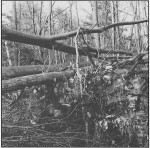Following the LTER Coordinating Committee meeting at Harvard Forest in Petersham, Massachusetts, site representatives visited several study sites both at Harvard Forest and at Hubbard Brook near Thornton, New Hampshire.
The Harvard Forest study area is composed of three main tracts, approximately 1,000 acres each on land that saw intensive agricultural, grazing and woodlot use after the population explosion of the 1850’s. Nitrogen studies are established on a natural woodlands reference site, where hemlock and pine dominate. Retrospec-tive studies utilize 85 years of historical data to contrast disturbance regimes, and various paleological approaches are used in a collaborative effort on spatial scales and species movement.
Temporal and spatial scales and the reciprocal dynamic between chestnut and hemlock with respect to fire and wind are being studied in a swamp/pond basin area with a presettlement history of fire. Post-settlement vegetation histories are also being compared.
A recent simulated windstorm experiment (see photo) in a structurally mature mixed hardwood forest involved clearing small canopy gaps to look at survival and growth of three co-occurring species of maple, as well as carbon gain and water use, among other post- disturbance features. To investigate atmosphere/biosphere exchange and biological/chemical fluxes, a sampling tower with an analysis shed have been installed.
The Hubbard Brook site is located in a largely unbroken tract of hardwcod forest, characterized by stream and lake ecosystems. Several uniform watersheds are used in a suite of stream manipulations, and the effects of acid rain on soils and surface waters have been studied since the mid-60’s. (Findings so far indicate a marked decline in lead related to the shift to unleaded fuels.)
Other research includes studies of herbicide treatment recovery in a watershed, water flow pathways in soils, nitrogen saturation, pre- and post-clearcut effects on soil pools, sodium concentrations in Mirror Lake (related to the salting of nearby highways), and declining populations of moose, dear and birds over the last 20 years. Two atmospheric towers collect data on gases and particles for an estimate of dry deposition to the forest.
The Mirror Lake study area, which now includes nearly all the lakeshore and catchment, provides an opportunity to understand long-term dynamics, benthic processes and mixing phenomena, as well as bacterial production and consumption. USGS deep wells allow the examination of the potential for water transport through fractures in bedrock. (Results indicate very little deep seepage so far.)
Tree and oil nutrient pools in a highly controlled sandbox field experiment are currently being quantified. In another instrumented plot experiment, the interaction of nitrificiation, sulfate absorption and soil acidification and leaching are being examined.

 Enlarge this image
Enlarge this image